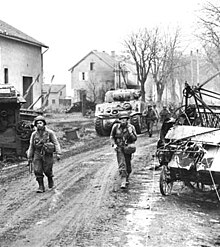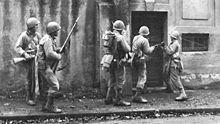Battle of Metz
| Battle of Metz | |||||||||
|---|---|---|---|---|---|---|---|---|---|
| Part of the Lorraine Campaign, World War II | |||||||||
 Troops of the U.S. 5th Infantry Division entering Metz on 18 November 1944. | |||||||||
| |||||||||
| Belligerents | |||||||||
|
|
| ||||||||
| Commanders and leaders | |||||||||
| George S. Patton | Otto von Knobelsdorff | ||||||||
The Battle of Metz was fought during World War II at the French city of Metz, then part of Nazi Germany, from late September 1944 through mid-December as part of the Lorraine Campaign between the U.S. Third Army commanded by Lieutenant General George Patton and the German Army commanded by General Otto von Knobelsdorff.[1] Strong German resistance resulted in heavy casualties for both sides.[2] The city was captured by U.S. forces and hostilities formally ceased on 22 November; the last of the forts defending Metz surrendered on 13 December.
Background
[edit]Metz is located between the rivers Moselle and Seille. The fortifications of Metz consisted of several forts and observation posts with connecting entrenchments and tunnels. The city had fallen to the German forces when France was defeated in 1940.[3] Following the fall of France, the city was immediately annexed to the Third Reich, as were most districts previously annexed to the Reich that had been lost in 1918. Most of the Nazi dignitaries assumed it was obvious that Metz, where so many German army officers were born,[note 1] was a German city. At that time, the Wehrmacht did not consider it an important location and the city's defenses were reduced with many guns and equipment removed, although the fortifications were still heavily defended and well armed.[4]
However, after the Allied "break out" from the lodgement established by the Normandy landings, the U.S. Third Army raced 400 miles (640 km) across France, with the German forces retreating in disorder. As Third Army supply lines became stretched, material (especially gasoline) became scarce, and Supreme Commander General Dwight D. Eisenhower called a halt to the Third Army advance so that supplies could be stockpiled for Operation Market Garden, an attempt to break into the vital (and heavily industrialized) German Ruhr Valley in the north. This pause by Third Army gave the Germans time to reorganize and fortify Metz, in an attempt to contain the Allied advance.[4]
By the end of August 1944, German forces in Lorraine had managed to reestablish a defensive line around Metz and Nancy. According to an order issued by Hitler in March 1944, fortress commanders were to hold their positions at all costs, surrendering only with Hitler's approval, which he would never give. Metz was surrounded by forts built by the Germans between 1870 and 1919, then allowed to decay by the French, who possessed the Lorraine region until it was retaken by Germany in 1940. The German commanders of the Metz forts were required to follow Hitler's "hold at all costs" order when attacked, in September 1944, by the U.S. Third Army led by General George S. Patton, who had reached Verdun before Eisenhower's order to halt the advance and conserve supplies. Hitler understood the pause was due to a supply shortage, and would not last, and he recognized that the Third Army posed a threat to the Saar region of Germany.[4] Hitler ordered his commanders to hold the Allies "as far west as possible," to give time for the strengthening of the West Wall, which had been depleted to build up the Atlantic Wall.
The defense of Metz was undertaken by the German First Army, commanded by General Otto von Knobelsdorff. The number of German troops positioned in the vicinity of Metz was equivalent to four and a half divisions.[4]
Battle
[edit]

Armored elements of the United States XX Corps, while on a reconnaissance operation in the direction of the Moselle, made contact with elements from the 17th SS Panzergrenadier Division on 6 September 1944. On 18 September, U.S. reconnaissance units encountered Wehrmacht Panzergrenadiers again. The U.S. forces had not expected the German forces to be in the area, and had to bring together their units that were spread out.[4] Several small scale attacks were made by the U.S. forces after this encounter.
The first U.S. attack was launched by the 95th Infantry Division, in which they attempted to capture a bridgehead to the north of Metz. This attack was repelled by the German forces, as was another attack on the city that followed. In another attack, the US forces captured a small bridgehead across the Moselle to the south of Metz.[4]

By the end of September, German forces positioned to the north had moved to the southern area of Metz. Some troops were also withdrawn from Metz. After this development, the XII Corps launched another attack but was countered by the German defenders. In the following two weeks, the U.S. forces limited themselves to small scale attacks and patrolling in the Metz area. During this time, the XX Corps underwent a training program, experimenting with methods of reducing the defenses of the fortress. By this time, the U.S. command had decided to attack Metz from its rear, coming from the east.[4]
On 3 November a new attack was launched by the U.S. forces, which resulted in the capture of the outer defenses with the aid of the tactics developed during the training process. On 14 November Generalleutnant Heinrich Kittel was appointed as the new commander of the German forces.[5] By 17 November, U.S. forces had managed to isolate most of the forts, and were attacking the city. German forces had been retreating since 17 November, and U.S. forces pursued them for the following two days.[6] U.S. forces entered Metz on 18 November, and on 21 November Kittel was wounded and subsequently captured. Although the city itself was captured by U.S. forces and hostilities formally ceased on 22 November, the remaining isolated forts continued to hold out.[4][7]
Direct assault was forbidden against the holdout forts in order to preserve artillery ammunition for the XX Corps' advance to the Sarre River and the isolated forts subsequently surrendered one by one following the surrender of Fort Verdun on 26 November. By the end of November, several forts were still holding out. The last of the forts at Metz to surrender was Fort Jeanne d'Arc, which capitulated to the U.S. III Corps on 13 December.[8]
Aftermath
[edit]Although the battle resulted in defeat for the German forces, it served the intended purpose of the German command of halting the advance of the U.S. Third Army for three months, enabling retreating German forces to make an organized withdrawal to the Sarre river and to organize their defenses. The level of casualties for both sides is unknown but high.[9]
The Germans were surprised at the American approach on the battlefield. Generaloberst Johannes Blaskowitz, C.O of Armeegruppe G, reviewed Patton's decision to launch a headlong attack straight into the fortifications of Metz by saying:
"A direct attack on Metz was unnecessary....in contrast a swerve northward in the direction of Luxemburg and Bitburg would have met with greater success and caused our 1st Army's right flank collapse followed by the breakdown of our 7th Army."
The military strategist and historian Liddel Hart remarked:
"Patton's 3rd Army began to cross the Moselle as early as 5 September, yet was little farther forward 2 weeks later - or indeed two months later." [10]
Notes
[edit]- Footnotes
- ^ Admiral Hans Benda (1877–1951), General Arthur Kobus (1879†1945), General Günther Rüdel (1883†1950), General Joachim Degener (1883†1953), General Wilhelm Baur (1883†1964), General Hermann Schaefer (1885†1962), General Bodo Zimmermann (1886†1963), General Walther Kittel (1887†1971), General Hans von Salmuth (1888†1962), General Karl Kriebel (1888†1961), General Arthur von Briesen (1891†1981), General Eugen Müller (1891†1951), General Ernst Schreder (1892†1941), General Ludwig Bieringer (1892†1975), General Edgar Feuchtinger (1894†1960), General Kurt Haseloff (1894†1978), General Hans-Albrecht Lehmann (1894†1976), General Theodor Berkelmann (1894†1943), General Hans Leistikow (1895†1967), General Rudolf Schmundt (1896†1944), General Wilhelm Falley (1897†1944), General Julius von Bernuth (1897†1942), General Johannes Hintz ( 1898 - 1944 ), General Herbert Gundelach (1899†1971), General Joachim-Friedrich Lang (1899†1945), General Heinz Harmel (1906†2000), Erich von Brückner (1896†1949), Helmuth Bode (1907†1985), Johannes Mühlenkamp (1910†1986), Peter-Erich Cremer (1911†1992), Joachim Pötter (1913†1992), Ludwig Weißmüller (1915†1943), Walter Bordellé (1918†1984) among others.
References
[edit]- ^ Video: Third Army blasts Nazi Strongholds, 1944/11/02 (1944). Universal Newsreel. 1944. Retrieved February 21, 2012.
- ^ "Metz, 1944 One More River". World War Two Books. Archived from the original on 2008-12-06. Retrieved 1 December 2008.
- ^ "General George Patton Interrogates a SS General, 1944". Eyewitness to History. Archived from the original on 20 December 2008. Retrieved 1 December 2008.
- ^ a b c d e f g h Col. Scott Pritchett. "Metz 1944". Campaign Awards of the Wehrmacht. Retrieved 1 December 2008.
- ^ Cole, Hugh M. (1950). The Lorraine Campaign (PDF). Historical Division, United States Army. p. 429.
- ^ Cole, Hugh M. (1950). The Lorraine Campaign (PDF). Historical Division, United States Army. p. 413.
- ^ Cole, Hugh M. (1950). The Lorraine Campaign (PDF). Historical Division, United States Army. p. 446.
- ^ Cole, Hugh M. (1950). The Lorraine Campaign (PDF). Historical Division, United States Army. p. 447.
- ^ Cole, Hugh M. (1950). The Lorraine Campaign (PDF). Historical Division, United States Army. p. 448.
- ^ Christer Bergström, "The Ardennes - Hitler's Winter Offensive", p. 28
External links
[edit]- Oral history interview with Frank Niedermayer, an infantryman during the Battle of Metz Archived 2012-12-12 at archive.today from the Veterans History Project at Central Connecticut State University
